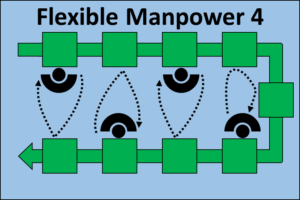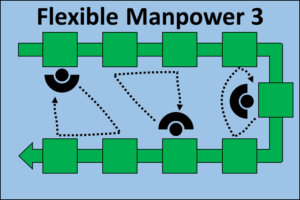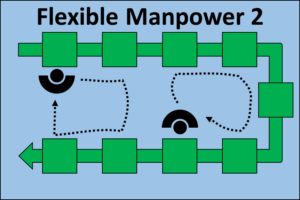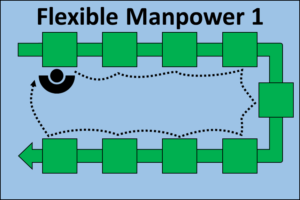 This is the final post in this series on flexible manpower lines. Since we completed the example line in the last post, I will give you a brief theoretical run-down on how to divide the work among multiple people. I will also show you some easier-to-manage but maybe not-quite-as-efficient alternative options, the bucket brigade and the rabbit chase.
This is the final post in this series on flexible manpower lines. Since we completed the example line in the last post, I will give you a brief theoretical run-down on how to divide the work among multiple people. I will also show you some easier-to-manage but maybe not-quite-as-efficient alternative options, the bucket brigade and the rabbit chase.
Flexible Manpower
Flexible Manpower Lines 3 – Example Line
 This third post in the series continues with the example on flexible manpower lines. Now we will investigate different options for these flexible manpower lines (also called Shoujinka 少人化). I will show you the details on all options between a single operator and the (sensible) maximum of six operators, and why for our example it does not make sense to use four or five operators.
This third post in the series continues with the example on flexible manpower lines. Now we will investigate different options for these flexible manpower lines (also called Shoujinka 少人化). I will show you the details on all options between a single operator and the (sensible) maximum of six operators, and why for our example it does not make sense to use four or five operators.
Flexible Manpower Lines 2 – Alternatives and Example
 Having a flexible manpower line is a good way to adjust the production capacity to changing demand while still keeping your system leveled. In this second post in my series on flexible manpower lines, I give you some alternatives before going into more details of an example line that we will set up for different numbers of operators in the next few posts.
Having a flexible manpower line is a good way to adjust the production capacity to changing demand while still keeping your system leveled. In this second post in my series on flexible manpower lines, I give you some alternatives before going into more details of an example line that we will set up for different numbers of operators in the next few posts.
Flexible Manpower Lines 1 – Introduction
 Production lines with manual labor often have the possibility of adjusting manpower due to demand. Such flexible manpower lines can work with different staff numbers, and can adjust the production output to the customer demand. At Toyota, such lines are also called Shoujinka (少人化, literally “few people production”). A gender neutral term would be “flexible staffing line”. This blog post will go into the details on how to set up such a line.
Production lines with manual labor often have the possibility of adjusting manpower due to demand. Such flexible manpower lines can work with different staff numbers, and can adjust the production output to the customer demand. At Toyota, such lines are also called Shoujinka (少人化, literally “few people production”). A gender neutral term would be “flexible staffing line”. This blog post will go into the details on how to set up such a line.
